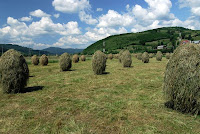Minsk, BELARUS
My Lonely Planet guidebook's introduction of Belarus starts with:

"Few people consider venturing into this hermetically sealed Soviet time capsule, notoriously ruled with an iron fist by its moustachioed megalomaniac, Alexander Lukashenko. ...here the KGB still listens in to phone calls and people keep their politics to a low whisper - you will feel as if the Cold War never ended. Westerners cool enough to come here...(blah blah)".
Brief history lession: In 1919 Belarus became the "Byelorussian Soviet Socialist Republic". It merged into the Lithuanian-Byelorussian Soviet Socialist Republic in 1921. In 1921 Joseph Stalin became the general secretary of the Soviet Communist Party. He started a policy of Russification to protect Byelorussia
 SSR from Western influences. In 1953 Stalin’s successor, Nikita Khrushchev continued with this policy. After seven decades as a constituent republic of USSR, Belarus declared itself sovereign on 27th July 1990 and attained independence in 1991. Since 1994, Alexander Lukashenko is leading the country.
SSR from Western influences. In 1953 Stalin’s successor, Nikita Khrushchev continued with this policy. After seven decades as a constituent republic of USSR, Belarus declared itself sovereign on 27th July 1990 and attained independence in 1991. Since 1994, Alexander Lukashenko is leading the country.I'm supposed to register with the police within 3 days of arrival, but honestly I don't have time for that and hope I can eventually leave - a free "unregistered" man.

Minsk is a beautiful and stunning city with the most amazing Stalinist Soviet buildings and statues I have seen in any city. Food is good, beer is "rough" and there's no local wine industry to talk about. The people are what make Minsk special to me. These are the friendliest and most helpful people I have come across anywhere in Eastern Europe, including Russia and the Baltics.
Over the next 8 days I, will criss-cross Belarus - from the west, maybe south, and up to the far
 north to spend some time with the family of my Minsk based Belarus host. I'm sure I'm in for an unforgettable treat. And, if I get caught by the KGB for not registering....I'm minced meat.
north to spend some time with the family of my Minsk based Belarus host. I'm sure I'm in for an unforgettable treat. And, if I get caught by the KGB for not registering....I'm minced meat.I think I already love Belarus! Few Western tourists here!










































